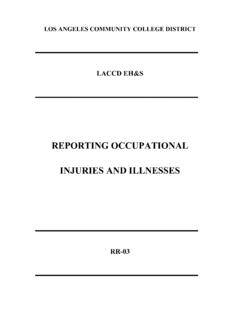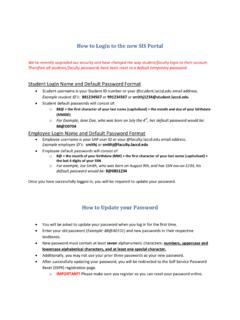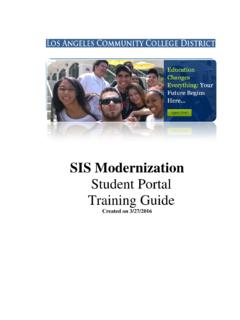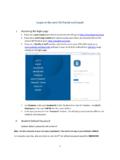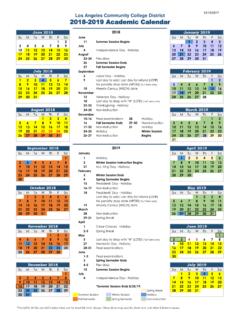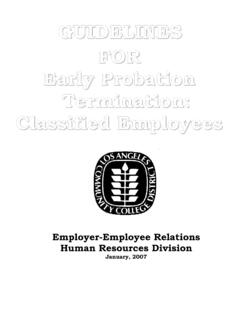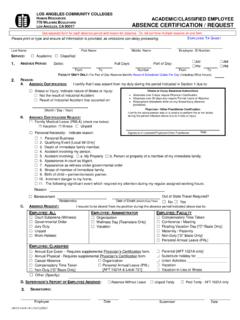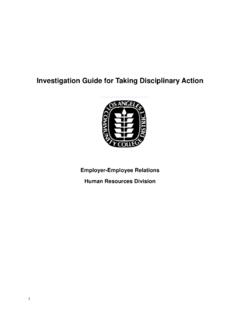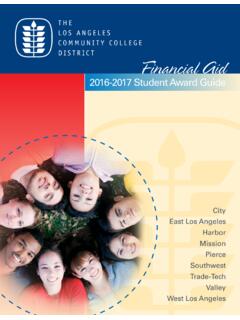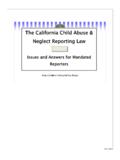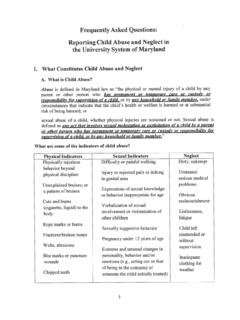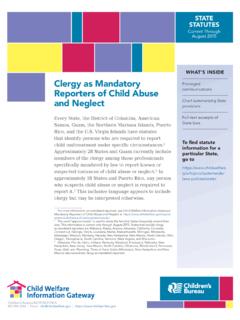Transcription of A GUIDE TO THE CHILD ABUSE AND NEGLECT …
1 A GUIDE to the CHILD ABUSE and NEGLECT reporting Act (CANRA). Presented by the laccd Human Resources Division and the Office of General Counsel June 2009. Notice The following slides discuss the types of reportable ABUSE and NEGLECT and their typical indicators. The slides discussing indicators only provide basic guidelines and are not intended to serve as an exhaustive list. Furthermore, some indicators, especially in the behavioral context, may not alone constitute ABUSE . Please exercise professional judgment accordingly. Your duty to report becomes mandatory once you know or reasonably suspect ABUSE or NEGLECT is occurring or has occurred. Introduction to CANRA. The California CHILD ABUSE and NEGLECT reporting Act ( CANRA, Penal Code sections ) requires certain professionals, known as mandated reporters, to report known or suspected instances of CHILD ABUSE or NEGLECT to law enforcement. Mandated reporters include: Teachers Instructional aides, teacher's aides, or instructional assistants Classified employees of any public school Administrators or employees of organizations whose duties require direct contact and supervision of children Licensees, administrators, or employees of a licensed community care or CHILD day care facility CANRA's Basic reporting Provisions A mandated reporter must make a report whenever, in his/her professional capacity or within the scope of his/her employment, he/she has knowledge of, or observes a CHILD (a person under 18) whom the mandated reporter knows or reasonably suspects has been the victim of CHILD ABUSE or NEGLECT .
2 Reasonable suspicion occurs when it is objectively reasonable for a person (based upon facts that could cause a reasonable person in a like position, drawing-- when appropriate-- on his or her training and experience) to suspect CHILD ABUSE or NEGLECT . If you are a mandated reporter and you reasonably suspect ABUSE has occurred, you must make two reports. First, you must report by telephone immediately. Then, you also must file a written report within 36 hours of receiving the information concerning the incident. Types of Reportable ABUSE and NEGLECT As a mandated reporter, you must report the following types of CHILD ABUSE and NEGLECT : 1. Sexual ABUSE a. Sexual assault b. Sexual exploitation 2. NEGLECT a. Severe NEGLECT b. General NEGLECT 3. Physical ABUSE a. Willful harming or injuring of a CHILD or the endangering of the person or health of a CHILD b. Unlawful corporal punishment or injury c. Non-accidental physical injury 4.
3 Emotional maltreatment 5. ABUSE in out-of-home care Sexual ABUSE : Sexual Assault Reportable sexual ABUSE can be classified into two categories, sexual assault and sexual exploitation. Sexual assault includes: Rape Statutory rape (when the offender is 21 or older and the victim is under 16 years of age). Rape in concert (gang rape). Incest Sodomy Lewd or lascivious acts upon a CHILD under 14, or with a 14 or 15 year old when the offender is at least 10 years older Oral copulation Sexual penetration CHILD molestation Sexual ABUSE : Sexual Exploitation Sexual exploitation refers to: Conduct involving matter depicting a minor engaged in obscene acts. Any person who knowingly promotes, aids, or assists, employs, uses, persuades, induces or coerces a CHILD to (1) engage in prostitution or a live performance involving obscene sexual conduct, or (2) pose or model alone or with others for purposes of preparing a film, photograph, negative, slide, drawing, painting, or other pictorial description involving obscene sexual conduct.
4 Any person who depicts a CHILD in-- or who knowingly develops, duplicates, prints, or exchanges-- any film, photograph, video tape, negative, or slide in which a CHILD is engaged in an act of obscene sexual conduct. Signs of Sexual ABUSE Sexual ABUSE may be present when the CHILD : Discloses the ABUSE to a friend, classmate, teacher, friend's parent, or other trusted adult Has an injury or a sexually transmitted disease that is unusual for his/her age group Has a history of previous or recurrent injuries or diseases Has unexplained injuries or disease ( , parent is unable to explain or offers inconsistent explanations). Becomes pregnant (However, pregnancy of a minor does not, in and of itself, constitute a basis for reasonable suspicion of sexual ABUSE ). Has physical trauma or irritation to the anal or genital area Has difficulty walking or sitting (due to genital or anal pain). Demonstrates sophisticated and age-inappropriate sexual knowledge or behavior (Voluntary sexual conduct between minors who are both under 14 and who are of similar age and sophistication is not considered CHILD ABUSE ).
5 Signs of Sexual ABUSE , con't. Undergoes drastic behavior changes Reports sleeping disturbances ( , bedwetting, nightmares, etc.). Experiences sudden change in appetite Has poor hygiene Engages in prostitution or excessive promiscuity Demonstrates overly compulsive or compliant behavior Shows fear of home life ( , frightened by parents). Has chronic fatigue, depression, apathy, or suicidal tendencies Abuses drugs or alcohol Refuses to dress for physical education Sexual ABUSE may be present when the adult caregiver: Is unduly protective of the CHILD or severely limits the CHILD 's contact with other children, especially of the opposite sex Is secretive and isolated Is jealous or controlling with family members NEGLECT NEGLECT is the negligent treatment or maltreatment of a CHILD by a parent or caretaker under circumstances indicating harm or threatened harm to the CHILD 's welfare. NEGLECT can be classified into two categories, severe and general.
6 Severe NEGLECT is the negligent failure of a parent or caretaker to protect the CHILD from severe malnutrition or a medically diagnosed non- organic failure to thrive. It also includes situations where the parent or caretaker willfully causes or permits the body or health of the CHILD to be endangered. General NEGLECT is the negligent failure of a parent or caretaker to provide adequate food, shelter, clothing, medical care, or supervision where no physical injury has occurred. Signs of NEGLECT NEGLECT may be present when the CHILD : Lacks adequate medical or dental care Begs or steals food or money Is frequently absent from school Is dirty, demonstrates poor hygiene, and/or is inadequately dressed for weather conditions States that no one at home provides supervision or care Is depressed, withdrawn, or apathetic Exhibits antisocial or destructive behavior Suffers from substance ABUSE , speech, eating or habit disorders NEGLECT may be present when the adult caregiver: Appears to be indifferent or apathetic to the CHILD Behaves irrationally or in a bizarre manner Is abusing alcohol or drugs Physical ABUSE Reportable physical ABUSE includes three classifications.
7 Willful harming or injuring of a CHILD or the endangering of the person or health of a CHILD includes situations where any person willfully inflicts unjustifiable physical pain on any CHILD , or otherwise causes or permits any CHILD to suffer unjustifiable physical pain. It also includes situations where the caregiver willfully causes or permits the person or the health of the CHILD to be placed in a situation such that his or her person or health is endangered. Unlawful corporal punishment or injury includes situations where any person willfully inflicts upon a CHILD any cruel or inhuman corporal punishment or any injury resulting in a traumatic condition. Non-accidental physical injury refers to all other types of physical injuries inflicted upon a CHILD by another person other than by accidental means. Physical ABUSE , con't. Physical ABUSE does not include the following situations: Injuries caused by mutual fighting between minors.
8 Injuries caused by the use of that amount of force that is reasonable and necessary for a person employed by or engaged in a public school (1) to quell a disturbance threatening physical injury to person or damage to property, (2) for self-defense, or (3) to obtain possession of weapons or other dangerous objects within the control of the CHILD . Injuries caused by reasonable and necessary force used by a peace officer acting within the course and scope of his/her duties. Signs of Physical ABUSE Typical injuries resulting from physical ABUSE may be injuries to the back surface of the CHILD 's body, injuries to the face, and injuries to multiple parts of the body. However, injuries to the shins, elbows, knees, and forehead are not typically sustained from ABUSE . Physical ABUSE may be present when the CHILD : Makes a statement that the injury was caused by ABUSE Has unexplained burns, bites, bruises, broken bones, or black eyes Has fading bruises or other marks noticeable after an absence from school Has difficulty walking or sitting Attempts to hide injuries ( , with clothing, etc.)
9 Seems frightened of the parents and protests or cries when it is time to go home Is clingy and forms indiscriminate attachments Shrinks at the approach of adults Signs of Physical ABUSE , con't. Exhibits drastic behavioral changes Is hypervigilant Suffers from seizures or vomiting Exhibits depression, self-mutilation, suicide attempts, substance ABUSE , or sleeping and eating disorders Physical ABUSE may be present when the adult caregiver: Offers conflicting, unconvincing, or no explanation for the CHILD 's injury Delays seeking or fails to seek medical care for the CHILD 's injury Describes the CHILD in a negative way Emotional Maltreatment Emotional maltreatment is reportable in situations where any person willfully inflicts unjustifiable mental suffering on any CHILD , or otherwise causes or permits any CHILD to suffer unjustifiable mental suffering. Mandated reporters may report suspected lesser types of emotional ABUSE falling short of the willful infliction of unjustifiable mental suffering, but are not required to do so.
10 You may make a report when you know or reasonably suspect a CHILD is suffering serious emotional damage or is at a substantial risk of suffering serious emotional damage, but at a level below unjustifiable mental suffering. In suspected instances of emotional maltreatment, you must exercise your professional judgment. Consistent, pervasive, and extreme behavior (such as the indicators in the following slides) may be somewhat indicative of unjustifiable mental suffering, but your determination must rely on the specific facts at hand. Signs of Emotional Maltreatment Emotional maltreatment may be present when the CHILD : Shows extremes in behavior, such as overly complaint or demanding behavior, extreme passivity, or aggression Acts either in an inappropriately adult manner ( , parenting other children) or in an inappropriately infantile manner ( , rocking or head-banging, etc.). Is delayed in physical or emotional development Is withdrawn, depressed, or apathetic Is clingy and forms indiscriminate attachments Exhibits behavioral problems Exhibits exaggerated fearfulness Is overly rigid in conforming to instructions of teachers or other adults Pays inordinate attention to details or exhibits little or no verbal or physical communication with others Signs of Emotional Maltreatment, con't.
